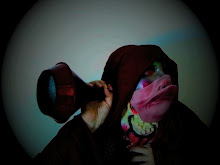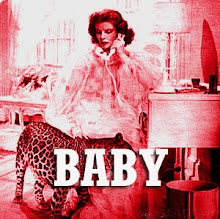
delirious hem recently called for responses to ...what does a feminist writer look like? click here
This is What a Feminist [Poet] Looks Like: what branch of feminism, model of feminist poetics, feminist icon, or etc. informs your poetry? Or, from which of these does your poetry diverge? Are there particular feminist tactics you employ? Do you consider yourself a feminist in many ways, but don't particularly involve it in the poetry? Feel free to take liberties with the questions! Short, long, essay, manifesto, whatever appeals to you!
I submitted a piece focusing more of what she sounds like...click here.
You asked what does a feminist poet look like?
And I want too say that we are not one. Indeed we are multifarious.
I want to reply to this question of who we are, more by exploring notions of what we are and how that effects our, and my methods. I will attempt to explain this through using quotes from the work of Luce Irigaray and Monique Wittig as they affect my work.
Indeed I am ventriloquizing their notions, here, for you. But lets [us] start from the space of the initial question of 'our look', the being seen. We are both visible and yet invisible , we are a nothing to be seen and this has its disadvantages but many advantages.
Irigaray in the Speculum of the Other Woman talks of this. The idea that a ‘nothing to be seen’… might have some reality, would be intolerable to man.
In this ‘virtual’ space, I am not one
Irigaray speaks of this 'she' indeed 'she' is 'the' whole project,
She, meaning me, and us, does not set herself up as a one, (single) female unit.
”She is not closed up, or around, one single truth or essence. The essence of a truth remains foreign to her. She neither has nor is a being. And she does not oppose a feminine truth to a masculine truth. The female sex takes place by embracing itself, by endlessly sharing and exchanging its lips, its edges, its borders, and their ‘content’, as it ceaselessly becomes other, no stability or essence is proper to her”.
Margaret Atwood in her Handmaiden's Tale relays a joke, that is said at the expense of woman but that instead actually outlines our key strength...
“Women, he said jokingly can't add up.
When I asked him what he meant?
He said, for women, one and one and one and one don’t make four.
What do they make? I said, expecting him to say five or three?
but no,
Just one, and one, and one and one, he said”.
(peels of ironic laughter)
This ability to take on complexities is a diffused space that is full of potential for women, writing, saying, thinking, and busy in being.
Irigaray again....
”It is already getting around - at what rate? In what contexts? In spite of what resistances - that women diffuse themselves according to modalities scarcely compatible with the framework of the ruling symbolic. Which doesn’t happen without causing some turbulence, we might even say whirlwinds, that ought to be reconfined within solid walls of principle, to keep them from spreading to infinity” The Sex Which Is Not One.
Instead we can an actively do take on otherness.
again...Irigaray
”Strictly speaking, one cannot say that 'she' mimics anything, for that would suppose a certain intention, a project, a minimum of consciousness.
She instead, is pure mimicry. Which is always the case for inferior species, of course. Needing to define essences, her function requires that she herself have no definition.”
Speculum of the Other Woman
These notions offer very broad and fecund spaces for feminist writers, poets, and theorists to reclaim voice and re shape knowledge claims of what it is to say.
What of my own methods you ask?
I am engaged in becoming the method of my own methods.
I listen carefully to the sound in language and write it.
I ventriloquize women's voices.
I multiply origins.
Dissociating signification's, I excavate voids, condense givens, ply and weave mannerisms, I embrace interferences and seek out and valorize polyphonies.
I am engaged in confusing genres and neutralizing techniques and media and understand this as a creative and politically creative method.
I am a paradox
Sounding language
… a multitude of multitudes
This is a method that produces notions and writing as scores of possibilities. It weaves possibilities into seemingly authentic calculations, a practice like that of Ada Countess of Lovelace.
It is a method that gives rise to monsters with voices, and monstrous voices.
Wittig, in Les Guerillieres, speaks of this colorful monster as in a permanent state of singing...?
“Somewhere there is a siren. Her green body is covered with scales. Her face is bare. The undersides of her arms are a rosy color. Sometimes she begins to sing.
The women say that of her song nothing is to be heard but a continuous O. That is why this song evokes for them, like everything that recalls the O, the zero, the circle the vulval ring”.
Paraphrasing the boys who wrote A Thousand Plateaus…lets, …Transpierce the mountains instead of scaling them, excavate the land instead of straitening it, or be it, be its voice, bore holes in space instead of keeping it smooth, and closed, turn the earth into Swiss cheese, or milk, our milk of words. Turn the frames of the known, the strictures of grammar, the separations of disciplines into their own gaping holes.
My method through this notion is a call to making these frames and language our creative zero.
Wittig again…”At this stage one must interrupt the calculations and begin again at zero. If one makes no mistake with the calculations, if one jumps with both feet together at just the right moment, one will not fall into the snake pit. If one makes no mistakes in the calculations, if one bends down at just the right moment, one will not be caught in the jaws of the trap. At this stage, one must interrupt the calculations, and begin again at zero”.
zero as a starting and being in point?
a zero plus one
plus one
plus one
Wittig… (and my own work continues her project), urges us to “take time, consider this new species that seeks a new language…” Listening to our own tongues, listening for the it in it.
make an effort to invent it
make an effort
and invent if you have to invention.
Thinking again offered a response click here
.. and then I left a comment saying...
Hi…thank you for raising such thoughtful questions re feminism and feminist practice especially in its relation to theory. And thank you for your delicious list of feminist informed writers, I look forward to reading though it. Re your mention of articulating a feminist poetics…I’d like to add to the discussion the work being done into the ‘said’ gap between practice and theory that is as we speak being filled up with a new type of theory, practice led theory and practice as theory. In this framework the insights and particularities, and the voice of a practice, are considered important and valid material to build and shape new theories and ideas across a wide range of disciplines, indeed it is making disciplines into tranies… (trandisciplinarity frameworks). It’s true some feminist theory is written for the world but some is written for a particular audience in that world. Those who can hear it. Innovative, aware, informed practice is always built for our ‘informed peers’, it always strives to move ahead and often way ahead of the dominant cultural and social frames. This isn’t snobbery or elitism but the way new things come into being through the giving and then receivership in some form. New thoughts, perspectives and means are always coming into being in this way. I am engaged in such a practice informed and creating a theory of sounded-language. I submitted the piece ‘what does a feminist poet sound like’ to the discussion on delirious hem and this is one of my key areas of interest and the core of my experimental work in theory/ literature and art.
Your right, in the past the gap between the poets practice and contemporary theory was considered a non issue, particularly and especially in academic circles. Indeed the connection was a non-event, an invisible gap in knowledge recognition. But artists/writers have always both made and made about ideas, issues, and shaped there works as knowledge claims regardless of their reception. But did we hear them? One of the complication was that the arguments/claims/ insights that privilege some notions over others, occurred within disciplines and institutions. Think the halls of the museum and the annals of art history and the halls of English literature departments etc. As the frame of cultural theory and literary and aesthetic theory has expanded, evolved and deliciously complicated each argument and firmly held belief, the artist/writer now ventriloquizes in words/paint not just the subject but their own inherent voice in a range of open experimental in a wide number of ways, transdisciplinary frameworks. The net being one of them
Before, in the not so distant past, ‘the muse’ was recognized as each one of us, practice be it art, writing, ‘the creative response’, lets call it had long been considered delivered muse-made via some sort of vacuum sealed package, though a magic blend of blessing, appeasement and struggle. The artists intensions to ‘the work’ were to be kept at an odd angle separate from the work itself and appreciation of the work that would follow by the expert, which was primarily considered in terms of its aesthetic value…, think of O’Keefe’s painted petals being ‘appreciated’ as examples of pure form…minimalism, precisionist, flattened picture plane etc, or Gertrude Stein’s work as having been built solely to confound and every now and then flirt the titillating secrets of her sexual life. But the artist’s voice and its strong voice at that, is now necessarily been heard as part of the conversation noting what is of value in culture and important to consider re knowledge frames. This voice is gaining ground now, fighting the good fight at the front, principally in academic circles and in
Feminist practice and theory has long been interested in overthrowing restrictive/ knowledge claims and in creating the voice to do it. And practice led theory and theory led practice is coming up with new ways of thinking and making that voice and its content. This is just one frame being established within a growing range of innovative theory informed practice by artists/writers who are working away in this area, rubbing out the ‘old boy’ standard. Ficto-critical frameworks and feminine ecriture in relation to practice-led theory are my two favorites…. This ongoing project for voice has and continues to be a long and hard fought for battle, not just for women, but those interested in inclusion of us all, indeed it might well be thought never over, as new voices enter the discussion and are at first always refused by the established order. But it is also one of mischief, and playfulness or gathering and disseminating ideas, or pulling threads together and of stepping back. Within connected communities of thinking, new approaches are critiqued and strengthened. I was glad to be part of the delirious hem forum as yet another example of this.
















